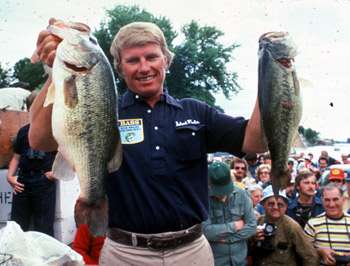
Name: Roland Martin
Hometown: Naples, Fla.
Technique: Shallow cranking — Fishing buoyant, shallow running crankbaits in water five feet deep or less.
History: Shallow cranking began with the invention of shallow running balsa crankbaits which Martin helped to pioneer in the early 1970s. The Big O, which is now produced by Cotton Cordell, was one of the first, and was immediately accepted because its uniquely-shaped bill deflected off cover like no other crankbait of the day.
Highlights: Martin credits shallow cranking with several tournament victories, including a one day 8-bass catch weighing 44 pounds — all caught on the same lure.
When to Use: Martin says without a doubt early spring and the prespawn are your best bet for big fish on shallow crankbaits. The fish are shallow preparing for the spawn and are looking for easy meals.
Where to Use: Shallow running crankbaits lend themselves well to fishing around shallow cover such as stumps, brushpiles and along the top of submerged grass, where other baits may get snagged. His favorite shallow cranking cover is any isolated wood cover adjacent to a dropoff. He credits the Big O with a 12-pound, 12-ounce largemouth caught from around one such stump. Martin says the bill helps prevent hang-ups, but the real reason they get snagged less is their buoyancy. If he feels a snag, Martin simply stops the retrieve and lets the bait float up over the cover before a hook digs in, then continues cranking.
Tackle: While tackle technology has changed since he began using this technique, Martin still prefers stout tackle. He uses a 7-foot, medium action Roland Martin Signature Series Carolina Rig/Pitching rod made by ProLine paired with a Bass Pro Shops Johnny Morris Elite 6.3:1 reel. Before the advent of superlines and braid, Martin used 25-pound-test monofilament, but now he uses 30- to 50-pound-test Power Pro. In clear water he will use a two foot leader of 10-pound-test fluorocarbon, but goes all braid in stained water. He prefers heavy line because it allows you to free snagged baits easier without losing them and heavy monofilament displaces more water and is more buoyant, helping to keep his bait shallower.
Lures: Martin uses older balsa wood Big O crankbaits because they are more buoyant than the newer plastic ones. Martin will, however, trade the factory hooks out for lighter wire hooks as they do not weigh as much and allow the bait to run shallower. Other baits he uses are a Mann's Baby 1-Minus and Bomber's 7A. Regardless of brand, Martin insists a pronounced wobble is necessary to attract more attention.
Basics: While he says shallow cranking is best in the springtime, Martin has a plan for shallow cranking during every season, each determined by water temperature. In warmer months, he uses all of his 6.3:1 reel's speed, slows down as fall approaches and cranks at a snail's pace in the dead of winter. Martin accidentally discovered decades ago that hanging up the bait during the retrieve isn't all bad if you let it float up after freeing it; this is where strikes often occur. Whether it is buried under a log, caught in some branches, or tangled in weeds, letting the bait rise momentarily seems to provoke more strikes. Martin will target cover no deeper than five feet so he can contact it with his bait. Brush, stumps and weeds are his favorite cover types. Cast beyond your target, crank until you bump it, pause to allow the bait to rise, then resume the retrieve if there's no strike.
One More Thing: Martin says the most important thing to remember when cranking skinny water is to not be intimidated by the thickest cover, save matted grass. A well-designed, buoyant crankbait with a square bill can come through the heaviest wood cover, but when you do encounter the inevitable snag, the light wire hooks will straighten out before your line breaks and you lose the bait.
